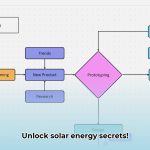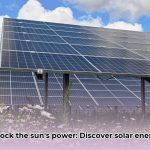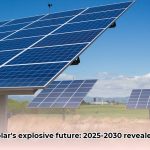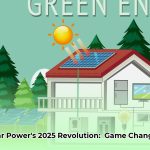Ever wonder how those solar panels on rooftops actually make electricity? It’s not magic, but it is pretty amazing! This article breaks down how sunlight gets turned into the power that runs your lights and appliances. We’ll explore two main ways this happens – using photovoltaic cells (think those panels on the roof) and concentrating solar power (imagine giant mirrors focusing sunlight). Learn more about different solar energy types [here](https://txgenco.com/different-types-of-solar-energy). We’ll walk you through the process step-by-step, explain the differences between these technologies, and even give you insights on making sure your solar setup works as efficiently as possible. Whether you’re considering solar panels or just curious, this is your guide to understanding the sun’s power.
Solar Power Conversion: Unveiling the Process
The sun’s energy is a potent, natural resource, and transforming it into electricity is a fascinating process. We’ll explore the two main ways we do this: using photovoltaic (PV) systems and concentrating solar power (CSP) systems. Get ready to uncover the secrets behind this clean energy source, including solar panel efficiency and renewable energy solutions!
Exploring Photovoltaic (PV) Systems: Harnessing Photon Energy
Imagine a field of tiny solar panels – each a miniature power station. These panels comprise individual photovoltaic (PV) cells, the workhorses converting sunlight into electricity. But how? Let’s break down the magic of residential solar and solar power generation:
- Sunlight’s Photon Powerhouse: Sunlight isn’t just light; it’s a stream of energy packets called photons, supercharged particles zipping around at the speed of light.
- The Electron’s Great Escape: When photons hit the silicon in a PV cell, they act like tiny billiard balls, knocking loose electrons from the silicon atoms. These electrons are now free to move and contribute to solar electricity.
- The Flow Begins: Creating Direct Current (DC): This movement of freed-up electrons creates an electrical current, a flow of energy. This is direct current (DC) electricity, flowing in one direction, powering solar devices.
- The Great Conversion: From DC to AC: Most homes and businesses use alternating current (AC) electricity – electricity that flows back and forth. Thus, we use an inverter to transform the DC electricity from our solar panels into the AC power to power our devices and appliances.
It’s not perfectly efficient. Think of catching raindrops in a bucket – you’ll get most, but some will miss. Cloud cover, sun angle, and panel efficiency affect how much of the sun’s energy we capture and transform. Solar panel technology is constantly improving, with newer panels converting a greater percentage of sunlight into usable electricity.
Understanding Concentrating Solar Power (CSP) Systems: Utilizing Solar Thermal Energy
CSP systems take a different approach, using mirrors to concentrate the sun’s power into a more intense beam. It’s like using a magnifying glass to start a fire – only on a much larger scale. This industrial solar energy approach captures thermal energy.
- The Mirror Field Magic: Thousands of mirrors precisely track the sun, reflecting its rays onto a single point, usually a tower. The result: intensely concentrated heat. Imagine the power of thermal solar energy!
- The Boiler Room in the Sky: This intense heat boils water, creating high-pressure steam. It’s like a giant solar-powered tea kettle for utility-scale solar!
- Spinning Turbines and Electricity: This high-pressure steam spins a turbine connected to a generator. This is similar to traditional power plants, except the initial energy source is the sun, not coal or gas. This turbine spins and generates electricity, showcasing concentrated solar power benefits.
Photovoltaic (PV) vs. Concentrating Solar Power (CSP): System Comparison
Here’s a quick look at the pros and cons of each system, comparing solar panel systems and solar thermal systems:
| Feature | Photovoltaic (PV) | Concentrating Solar Power (CSP) |
|---|---|---|
| Advantages | Relatively inexpensive to install, easily scalable, requires less maintenance, directly converts sunlight to electricity, suitable for residential and commercial use, offers renewable energy integration | Very high efficiency in direct sunlight, potential for energy storage (thermal), applicable for utility-scale solar power, can operate during peak demand |
| Disadvantages | Lower efficiency compared to CSP, output depends on sunlight, less effective in areas with frequent cloud coverage, battery storage often needed for continuous power | Higher upfront costs, requires large land areas, complex systems, and may have environmental impact (water usage for cooling), less effective on cloudy days |
The Sun Doesn’t Always Shine: Tackling Intermittency with Renewable Energy Storage
A big challenge with solar power is intermittency – the sun doesn’t shine 24/7! Several clever solutions are being developed to address this, enhancing solar energy reliability:
- Battery Powerhouses: Batteries store excess solar energy generated during the day, providing power when the sun goes down or on cloudy days. This is like having a giant rechargeable battery to back up your solar panels, promoting energy independence. Modern lithium-ion batteries are increasingly popular due to their high energy density and long lifespan.
- Grid Power Sharing: Connecting solar farms to the wider electricity grid allows for energy sharing. If one area has excess solar power, it can be shared with areas experiencing low sunlight. It’s like a power-sharing network, increasing grid resilience! This requires a robust and intelligent grid infrastructure capable of handling bidirectional power flow.
- Hybrid Systems: Combining Strengths: Combining solar power with other renewables like wind power creates a more stable and reliable energy supply. This is a smart way to ensure a constant flow of clean energy, improving renewable energy mix. Smart inverters can manage the power flow between different energy sources and the grid.
- Thermal Storage: CSP plants can store energy by heating materials like molten salt. This stored heat can then be used to generate electricity even when the sun isn’t shining, providing a more consistent power output.
The Future is Bright: Embracing Sustainable Energy Source
The journey of how solar energy transforms into electrical energy is full of amazing technology and ongoing innovation and is critical for renewable energy transition. Constant improvements are making solar energy more efficient, affordable, and reliable and are key to sustainable solutions. It’s likely to play an even bigger role in meeting our global energy needs in a way that’s both sustainable and environmentally friendly. The future of clean energy is truly sunny! Researchers are exploring new materials and designs that could significantly increase solar panel efficiency and reduce costs.
Optimizing Solar Panel Inverters: Essential Guide
Key Takeaways:
- The solar inverter market is booming, with several types vying for dominance: microinverters, string inverters, and hybrid inverters. Each offers unique advantages and disadvantages to maximize solar energy output.
- Microinverters excel in partially shaded areas, boosting energy output, but are more expensive. String inverters are cost-effective for uniformly sunlit systems. Hybrid inverters integrate energy storage, increasing self-sufficiency and energy security.
- Leading brands like Enphase, SolarEdge, Tesla, and SMA each offer different technologies. Consider your needs and budget when selecting a brand to enhance your solar energy system.
Choosing the right inverter is crucial for maximizing efficiency, reliability, and return on investment. This involves careful consideration of factors like your home’s energy needs, roof orientation, and available sunlight. Long-term planning is crucial to maintain efficient systems. Keeping up with advancements in inverter technology and considering future expansion are vital. Smart inverters can also provide valuable data on system performance and allow for remote monitoring and control.
Understanding Solar Energy Conversion Efficiency
Sunlight, the ultimate source, is captured by photovoltaic (PV) cells. These cells, typically made of silicon, use the photovoltaic effect: photons of light strike the material, knocking loose electrons, creating an electrical current—direct current (DC). This DC electricity isn’t directly usable in most homes. It needs converting to alternating current (AC), which our appliances run on. That’s where the solar inverter comes in, improving electricity access.
The Critical Role of Solar Inverters
Think of the solar inverter as the intermediary. It’s the crucial component that transforms the DC electricity from your solar panels into the AC electricity needed for your home. It’s also often responsible for managing the flow of energy to and from your home battery storage system. Without it, your solar panels are useless for powering your household, hindering solar energy utilization. Modern inverters also incorporate advanced features like Maximum Power Point Tracking (MPPT) to optimize energy harvest from the solar panels.
Solar Inverter Types: System Design Comparison
Several types of inverters cater to various needs and system designs. Let’s examine the key players to help with solar power selection:
- String Inverters: These are the most common and cost-effective. They convert power from an entire string of solar panels. However, if one panel is shaded, it impacts the entire string’s output. They are best suited for systems where all panels receive consistent sunlight.
- Microinverters: These small devices are connected to individual panels. Shading one panel doesn’t affect others. They offer superior performance in partially shaded areas but increase the overall system cost. Microinverters also allow for individual panel monitoring, which can help identify and address any performance issues.
- Hybrid Inverters: These integrate battery storage, allowing you to store excess solar energy for nighttime use. They reduce dependence on the grid, potentially lowering electricity bills and promoting energy resilience. Hybrid inverters also often include features like backup power during grid outages.
| Inverter Type | Pros | Cons | Best For |
|---|---|---|---|
| String Inverter | Cost-effective, high efficiency in optimal conditions, well-established technology, easier to install and maintain, suitable for large-scale installations | Vulnerable to shading, single point of failure, entire string performance affected by one panel, requires careful string sizing, limited monitoring capabilities, less flexible for complex roof designs | Uniformly sunlit roofs, budget-conscious systems, large arrays with consistent sunlight, homeowners seeking simplicity |
| Microinverter | Panel-level optimization, high reliability, individual panel monitoring, flexible design, enhanced safety (lower DC voltage), can handle shading better, easier expansion, longer lifespan | Higher initial cost, more complex installation, potential for more points of failure, may require more wiring, increased labor costs, communication issues can arise, potential interference with other devices, more difficult to troubleshoot | Partially shaded roofs, complex roof designs, maximum energy harvesting, systems where individual panel performance is critical, homeowners wanting detailed monitoring |
| Hybrid Inverter | Energy storage integration, grid independence, backup power during outages, reduced reliance on grid, potential for cost savings, optimized self-consumption, integration with smart home systems, contributes to grid stability, allows for time-of-use optimization | More expensive than string inverters, complex setup, battery maintenance requirements, requires specialized knowledge, limitations on battery capacity, dependency on battery lifespan, potential for battery degradation, requires more space for energy storage components, higher installation costs | Off-grid or grid-tied systems with battery storage, homes wanting energy independence, homeowners wanting backup power, systems aiming for self-consumption, areas with time-of-use electricity pricing |
Solar Panel Inverter Selection Guide: Maximizing Energy Storage
Choosing the right inverter is a critical decision, impacting system efficiency and cost. Here’s a step-by-step approach to guide home energy consumption:
-
Assess Your Energy Needs: How much electricity does your home consume daily? Analyze your past electricity bills to determine your average energy usage. This determines the required inverter capacity, impacting solar power solutions.
-
Evaluate Your Roof: Is your roof predominantly sunny or partially shaded? Consider the orientation and tilt of your roof, as well as any potential obstructions. Shading heavily influences inverter choice and solar panel suitability.
-
Consider Energy Storage: Do you want a battery backup for nighttime use or grid independence? Research different battery technologies and their associated costs and lifespans. Hybrid inverters are ideal for this, providing renewable energy backup.
-
Research Inverter Brands and Models: Enphase, SolarEdge, Tesla, and SMA are leading brands, each with different technologies and price points. Read reviews and compare specifications to find the best option for your needs. Look for warranties and efficiency ratings when purchasing renewable energy equipment.
-
Consult with a Qualified Installer: A professional solar installer can help you assess your needs and recommend the best inverter for your specific system, ensuring optimal solar panel installation. They can also provide valuable insights on local regulations and incentives.
Remember, the best inverter isn’t a one-size-fits-all solution. It depends on your individual circumstances. By carefully considering these factors, you can select an inverter that maximizes your solar energy system’s performance and return on investment. Consider future expansion – choose an inverter that can accommodate additional solar panels or batteries if you plan to increase your system size in the future.
Maintenance Guide: Optimizing Solar Energy System Performance
Ever wonder how those sleek solar panels on your roof actually generate electricity? It’s a process of converting sunlight’s energy into usable power, and understanding this process is key to maximizing your system’s performance. Let’s dive in for solar panel maintenance tips! Regular maintenance not only ensures optimal performance but also extends the lifespan of your solar investment.
Harnessing the Sun: Converting Sunlight to Renewable Electricity
Sunlight, that seemingly limitless resource, is actually a torrent of tiny energy packets called photons. These photons bombard your solar panels, specifically the photovoltaic (PV) cells within them. Each PV cell is a sandwich of semiconductor materials, usually silicon. When a photon hits a silicon atom, it knocks loose an electron. This creates a flow of electrons –that’s electricity! Think of it like shaking a tree: the photons are the shaking, and the electrons are the falling apples. We then collect these “apples” (electrons) to create a usable electric current for solar renewable energy. Different types of silicon are used, including monocrystalline and polycrystalline, each with varying efficiencies and costs.
Solar Panel Maintenance: Importance of Regular Cleaning
Your solar panels are the workhorses of your system. They’re exposed to the elements, so regular care is vital for sustainable energy. What does that mean?
-
Cleaning: Dust, leaves, bird droppings, pollen, and other debris can significantly reduce efficiency, limiting residential power. A simple cleaning with water and a soft brush every few months keeps your panels working optimally, maintaining efficient energy use. Use caution when cleaning and avoid using harsh chemicals or abrasive materials. However, frequency depends on your climate. A desert dweller might need more frequent cleanings than someone in a rainforest environment. Consider the angle of your panels as well; steeper angles tend to shed debris more easily.
-
Inspection: Walk around your panels regularly. Check for cracks, loose connections, corrosion, or any other signs of damage, promoting energy efficiency. Look for discoloration or delamination of the panel surface. Early detection prevents larger, more costly problems down the road. Keep an eye out for nests from birds or other animals that could damage the system.
Maintaining Other Crucial Components: Inverter and Battery Care
Your solar system encompasses more than just the panels. The inverter converts the direct current (DC) electricity generated by the panels into the alternating current (AC) electricity you use in your home, ensuring residential power. Your system might also include batteries for energy storage. All these components require attention for sustainable energy solutions.
- Inverter Maintenance: Inverters have a finite lifespan, typically around 10-15 years. Regular inspection and professional maintenance can extend their life, increasing renewable energy reliability. Keep them cool and clean, ensuring adequate ventilation. Monitor the inverter’s display for any error codes or unusual readings. Check the wiring connections for tightness and corrosion.
- Battery Care (If Applicable): Batteries need specific care depending on their type (lead-acid, lithium-ion, etc.). Refer to your manufacturer’s instructions for optimal maintenance, maximizing residential power storage. Ensure proper ventilation for lead-acid batteries to prevent the buildup of explosive gases. Monitor the battery’s state of charge and avoid deep discharges, which can shorten their lifespan.
Proactive Strategies for Peak Performance: System Monitoring
Regular maintenance isn’t just about fixing problems; it’s about preventing them. This is where proactive strategies come in for renewable energy generation.
- Monitoring: Smart monitoring systems allow you to track your system’s performance in real-time. Monitor energy production, voltage, current, and other key metrics. This early warning system lets you catch potential issues before they become major problems, enhancing solar energy management. Set up alerts to notify you of any significant performance drops.
- Professional Inspections: Schedule annual (or more frequent, depending on your system’s complexity and location) professional inspections. Experts can identify hidden problems and ensure your system runs efficiently. Technicians can also perform thermal imaging to detect hotspots or other anomalies.
Maintenance Checklist: Tactics for Solar Energy Optimization
Here’s a table to summarize your maintenance tasks for solar power solutions:
| Task | Frequency | DIY? | Notes |
|---|---|---|---|
| Panel Cleaning | Quarterly (adjust as needed) | Yes | Use soft brush and water; avoid harsh chemicals; consider hiring professionals for hard-to-reach panels, promoting energy saving. Schedule cleanings more frequently in dusty or polluted areas. |
| Panel Inspection | Monthly | Yes | Check for damage, loose connections, debris accumulation, promoting energy security. Pay particular attention to the mounting hardware and ensure it is secure. |
| Inverter Inspection | Bi-Annually | No | Needs a professional to completely check this; look for error codes, overheating, or unusual noises, ensuring energy reliability. Check the cooling fans and vents for obstructions. |
| System Check (Professional) | Annually (or more frequently) | No | Comprehensive inspection by a qualified technician; ensures proper operation, including electrical connections and system performance, promoting solar panel maintenance. Have the technician check the grounding system to ensure proper safety. |
| Vegetation Management | As-needed | Yes (if simple) | Trim trees and shrubs near panels; prevent shading and optimize sunlight exposure, increasing energy efficiency. Remove any weeds or vines that may be growing near the panels. |
| Battery Inspection (If applicable) | Quarterly | Yes (with caution) | Visually inspect battery terminals and connections for corrosion, cracks, or leaks. Ensure proper ventilation. Follow manufacturer guidelines for specific maintenance procedures. |
Key Takeaways:
- Regular cleaning and inspection extend the life and boost the efficiency of your solar panels, enhancing solar energy investment.
- Proactive maintenance practices like system monitoring can prevent costly repairs, promoting energy resilience.
- Professional maintenance is crucial for thorough checks, complex repairs, and ensuring safety, ensuring solar energy reliability. Hire a certified solar technician to perform these inspections.
The frequency of maintenance varies based on your location, climate, system type, and more. Document all maintenance activities and keep records of inspections, repairs, and replacements. This information will be helpful for warranty claims and future troubleshooting. Consider investing in a snow removal tool if you live in an area with heavy snowfall.
Future-Proofing Guide: Unlocking Ultimate Potential of Solar Energy
How does the sun’s energy become the electricity powering your home? Let’s explore this amazing transformation and sustainable power generation!
Photovoltaics: Solar Electricity Explained
Sunlight, essentially a stream of photons (light particles), is the key for utility solar. These photons strike specialized semiconductor materials within photovoltaic (PV) cells, typically silicon. This interaction knocks loose electrons within the material, creating green electricity. This release creates an electrical current – that’s the photovoltaic effect in action of solar power generation. Think of it like shaking a tree – the photons are the shaking, and the electrons are the fruit falling down. These freed electrons then flow through a circuit, generating electricity, contributing to sustainable power generation. Researchers are constantly working on improving the efficiency of PV cells, exploring new materials beyond silicon.
Different PV cell types exist, each with its own production process, level of efficiency, and lifespan for renewable production. Monocrystalline cells, with their dark and uniform surface, are typically the most efficient but also the most expensive. Polycrystalline cells, with a speckled appearance, offer a good balance of cost and performance. Thin-film solar cells, lighter and flexible, present alternatives but generally possess lower efficiency. The choice depends on your needs and budget for green electricity. Bifacial solar panels, which can generate electricity from both sides, are also gaining popularity.
Harnessing Solar Power Beyond PV Cells
Photovoltaic cells aren’t the only way to generate electricity from sunlight. Concentrating Solar Power (CSP) systems use mirrors to focus sunlight onto a receiver, heating a fluid that then drives a turbine to generate electricity – a more industrial-scale approach. Imagine a massive magnifying glass—that’s the essence of CSP for clean energy solutions. Both PV and CSP systems have advantages and disadvantages regarding cost, efficiency, and land use. CSP plants can also incorporate thermal storage, allowing them to generate electricity even when the sun isn’t shining.
Overcoming Challenges: The Role of Energy Storage
Solar energy’s biggest challenge? It’s intermittent, threatening sustainable power. The sun doesn’t shine 24/7. This is where energy storage solutions become vital for renewable production. Batteries, ranging from small home units to large-scale grid storage projects, offer one approach, enhancing green electricity access. Lithium-ion batteries are currently the most common choice, but other technologies like flow batteries are also being developed. Pumped hydro storage, using excess solar energy to pump water uphill and later releasing it to generate electricity, is another method for energy resilience. Effective energy storage is crucial for unlocking the ultimate potential of solar energy- a future-proofing guide. Smart grids and demand response programs can also help to balance the electricity supply and demand.
A Future Powered By Solar: Renewable Production
Several factors are driving the continued growth of solar energy:
Costs are decreasing, making solar power increasingly affordable for sustainable power. Innovations in manufacturing and economies of scale are contributing to lower prices. Governments worldwide are implementing supportive policies and incentives, enhancing renewable production. Tax credits, rebates, and feed-in tariffs are encouraging solar adoption. Technological advancements, like perovskite solar cells promising higher efficiency, are on the horizon for green electricity. Tandem solar cells, which combine different semiconductor materials, are also showing promise. Yet, land use considerations and the environmental impact of manufacturing solar panels remain important areas for ongoing research. Responsible siting and recycling programs are essential for minimizing the environmental impact of solar energy.
Steps to Go Solar: Sustainable Power
- Assessment: Evaluate your energy needs and available sunlight for utility solar. Consider factors like roof orientation, shading, and local climate conditions.
- Installation: Choose a reputable installer; understand permitting processes for renewable production. Obtain multiple quotes and compare the experience and qualifications of different installers.
- Maintenance: Regularly inspect your system; schedule professional maintenance for green electricity. Follow the manufacturer’s recommendations for cleaning and maintenance.
- Monitoring: Track your energy production and consumption. Consider expanding capacity or adding energy storage as needed for sustainable power. Utilize online monitoring tools to track system performance and identify potential issues.
Solar Energy Pros and Cons: Clean Energy Balance
| Pros | Cons |
|---|---|
| Renewable and sustainable | Intermittent energy source, reliant on weather conditions, requires alternative sources or storage to ensure a reliable power supply. This can increase the overall cost and complexity of the system. |
| Reduces carbon footprint, contributes to cleaner air and decreased greenhouse gas emissions, offsets reliance on fossil fuels, promotes environmental preservation | High initial investment costs, may require financing or incentives to make it economically feasible for some consumers, return on investment can vary based on factors like location, usage, and system size. The payback period can be longer than expected if energy prices are low. |
| Decreasing costs, solar panel prices have significantly decreased in recent years, making it an increasingly competitive energy source, promotes energy equity | Land use requirements, large-scale solar farms require significant land areas, potential conflicts with agricultural land or natural habitats, visual impact concerns in rural areas, responsible land planning is essential. Careful consideration should be given to the ecological impact of solar farms. |
| Diverse applications (residential, commercial, industrial), can be used for powering homes, businesses, and large-scale industrial operations | Weather dependence, solar panel output varies depending on sunlight availability, cloud cover, and seasonal changes, requires a backup power source or energy storage to ensure consistent energy supply, not suitable for regions with limited sunlight. Microgrids and smart inverters can help to mitigate the impact of weather variations. |
| Job creation potential, the solar industry creates numerous jobs in manufacturing, installation, maintenance, and research, contributing to economic growth | Manufacturing impacts on environment, production of solar panels involves the use of certain materials and processes with potential environmental consequences, proper recycling and disposal of solar panel components is crucial, requires ongoing research to minimize the environmental footprint. End-of-life management of solar panels is a growing concern. |
Key Takeaways:
- Solar energy offers a significant opportunity for a cleaner, more sustainable energy future and utility solar.
- Photovoltaic (PV) cells and Concentrating Solar Power (CSP) systems are primary methods for harnessing solar energy and enabling renewable production.
- Energy storage solutions are crucial to overcome the intermittency of solar power for sustainable production.
- Technological advancements and supportive government policies are driving widespread solar adoption, benefiting green electricity.
- Careful consideration of environmental factors and a long-term perspective are essential for sustainable power generation. Engaging with local communities and addressing their concerns is important for the successful deployment of solar energy projects.
- Wind Energy For Residential: Is It Right For Your Home? - November 28, 2025
- Wind Energy Flyer: Design a Powerful Green Campaign Show - November 26, 2025
- What Types Of Jobs Does Wind Energy Create? - November 23, 2025
















